鲁教版英语六年级下册语法
鲁教版六年级英语下册重点短语及句子

鲁教版六年级英语下册重点短语及句⼦六年级下册期末常考知识点汇总1.--when is +主语+birthday?某⼈的⽣⽇什么时候?when疑问副词,引导提殊疑问句,其结构为“when+⼀般疑问句?”when可以对年、⽉、⽇以及时刻进⾏提问或者询问某⼀动作发⽣的时间。
--It 's+⽉+⽇,+年。
是...年...⽉ ...⽇.When is your birthday?My birthday is on May 2nd./It is on May 2nd2.—how old +be+主语?...多⼤年纪/⼏岁了?How old 意为“多⼤年纪;⼏岁”,⽤来询问年龄。
答语常⽤--主语+be+基数词 +years/months old. ......岁3.want to do sth. 想要做某事4.happy birthday⽣⽇快乐,其答语为:thank you./thanks a lot./thank you very much.5.⼀年⼗⼆个⽉份,⽉份前常⽤介词in。
Month的复数是months。
6.do you want to come to my birthday party?(第2页)7.be busy doing sth.=be busy with sth.忙于(做)某事。
She is busy doing her homework.=She is busy with her homework.她正忙着做家庭作业。
8. When is Ailce's birthday?(第2页)艾丽斯的⽣⽇是什么时候?解析:Ailce's为名词所有格形式,意为“艾丽斯的”。
名词所有格表⽰⼈或物的所有和所属关系,在句中作定语名词所有格的构成有's所有格、of所有格和双重所有格三种形式。
1)'s所有格的构成。
⼀般情况下在单数名词的词尾加's。
Jim's book以-s 或-es结尾的复数名词,在词尾加“'”。
六年级英语下册知识讲义-Units 5-6语法归纳-鲁教版(五四学制)
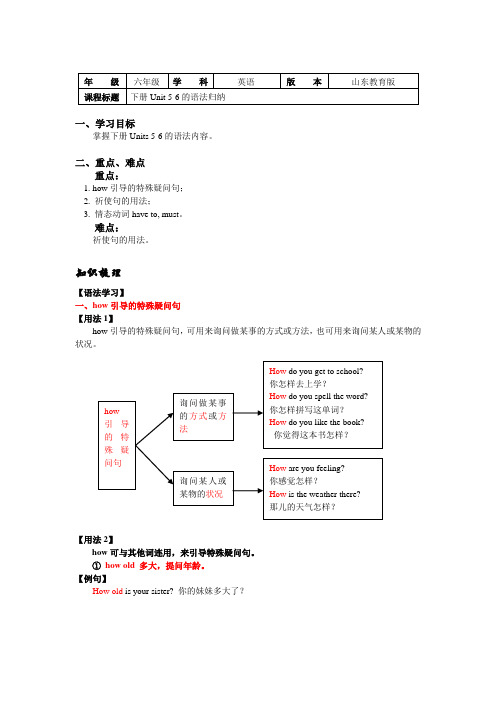
一、学习目标掌握下册Units 5-6的语法内容。
二、重点、难点重点:1. how引导的特殊疑问句;2. 祈使句的用法;3. 情态动词have to, must。
难点:祈使句的用法。
知识梳理【语法学习】一、how引导的特殊疑问句【用法1】how引导的特殊疑问句,可用来询问做某事的方式或方法,也可用来询问某人或某物的状况。
【用法2】how可与其他词连用,来引导特殊疑问句。
①how old 多大,提问年龄。
【例句】How old is your sister? 你的妹妹多大了?②how many 多少,提问可数名词的量。
【例句】How many bananas do you want? 你想要多少香蕉?③how much 多少,提问不可数名词的量。
多少钱;提问价格。
【例句】How much water is there in the bottle? 瓶子里有多少水?How much is the sweater? 这件毛衣多少钱?④how long 多长时间,提问一段时间。
多长,提问物体的长度。
【例句】How long does it take you to get home? 你到家要花费多长时间?How long is the classroom? 这教室多长?⑤how far 多远,提问距离。
【例句】How far is the park from here? 公园离这儿多远?【拓展】①how soon 多快。
【例句】How soon will he be back? 他多快回来?②how often 多久一次,提问频率。
【例句】How often do you go to the movie? 你多久去看一次电影?【考题链接】1. —____ is it to the train station?—About six kilometers.A. How longB. How farC. How muchD. How often答案:B思路分析:根据答语“大约六公里”可知问句询问距离,故排除A, C, D三项。
鲁教版五四制英语六年级下册Unit4单元语法归纳:频率副词总结

鲁教版五四制英语六年级下册Unit4单元语法归纳:频率副词总结单元语法归纳:频率副词总结说起“频率副词”,你可能不太了解。
谈起often,always,usually,sometimes,你一定会脱口而出,它们是一般现在时的“标志词”。
它们是表示频率的副词。
这些词表示经常性动作或情况,不是某一具体动作,常用于一般现在时。
这些频率副词在句子中的位置比较灵活,可以用于句首、句中和句末。
在句中的位置一般在系动词be,情态动词(can,may,must 等)或助动词(do,does 等)之后,行为动词之前。
这些频率副词在表示动作发生的频率时,程度上有所不同,可这样表示:always>usually>often>sometimes1. always意为“总是,一直”。
这是频率最大的词,表示动作重复,状态继续,中间没有间断。
如:Mary is always late for school. 玛丽总是上学迟到。
2. usually意为“通常”,表示习惯动作,频率仅次于always,相当于most often。
表示除个别情况外,基本上没有变化。
如:He usually gets up at 6 o'clock. 他通常6点钟起床。
3. often意为“时常,经常”,表示动作重复,中间有间断,表示发生的频率比usually 要小,但比sometimes要大。
如:I often go to school by bike,but sometimes I go to school by bus. 我经常骑自行车上学,但有时乘公共汽车去。
4. sometimes意为“有时”,表示发生的频率最小。
sometimes 一词在书写时要十分小心,若分开写成some times就成了“好几次,数次”。
如:He has lunch in the factory sometimes. 他有时在工厂吃午饭。
I read this story some times. 这个故事我读过好几次了。
鲁教版英语(五四制)六年级下册_Unit6_单元要点梳理总结
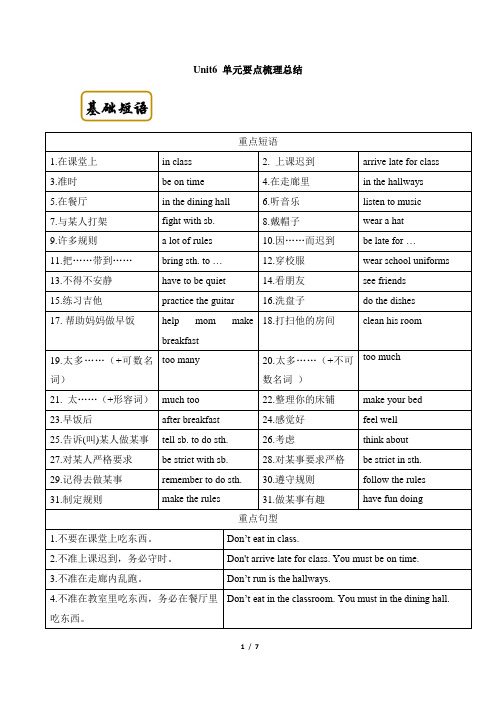
Unit6 单元要点梳理总结重点短语1.在课堂上in class2. 上课迟到arrive late for class3.准时be on time4.在走廊里in the hallways5.在餐厅in the dining hall6.听音乐listen to music7.与某人打架fight with sb. 8.戴帽子wear a hat9.许多规则 a lot of rules 10.因……而迟到be la te for …11.把……带到……bring sth. to … 12.穿校服wear school uniforms 13.不得不安静have to be quiet 14.看朋友see friends15.练习吉他practice the guitar 16.洗盘子do the dishes17. 帮助妈妈做早饭help mom makebreakfast18.打扫他的房间clean his room19.太多……(+可数名词)too many 20.太多……(+不可数名词)too much21. 太……(+形容词)much too 22.整理你的床铺make your bed23.早饭后after breakfast 24.感觉好feel well25.告诉(叫)某人做某事tell sb. to do sth. 26.考虑think about27.对某人严格要求be strict with sb. 28.对某事要求严格be strict in sth.29.记得去做某事remember to do sth. 30.遵守规则follow the rules 31.制定规则make the rules 31.做某事有趣have fun doing重点句型1.不要在课堂上吃东西。
Don’t eat in class.2.不准上课迟到,务必守时。
Don't arrive late for class. You must be on time.3.不准在走廊内乱跑。
鲁教版英语六年级下册语法
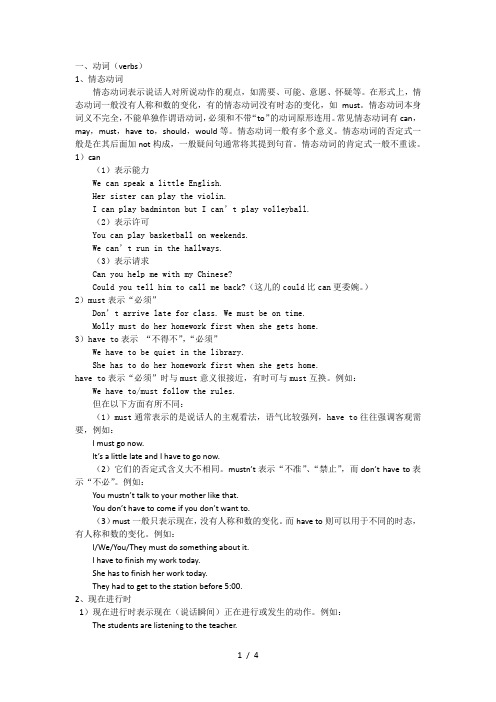
一、动词(verbs)1、情态动词情态动词表示说话人对所说动作的观点,如需要、可能、意愿、怀疑等。
在形式上,情态动词一般没有人称和数的变化,有的情态动词没有时态的变化,如must。
情态动词本身词义不完全,不能单独作谓语动词,必须和不带“to”的动词原形连用。
常见情态动词有can,may,must,have to,should,would等。
情态动词一般有多个意义。
情态动词的否定式一般是在其后面加not构成,一般疑问句通常将其提到句首。
情态动词的肯定式一般不重读。
1)can(1)表示能力We can speak a little English.Her sister can play the violin.I can play badminton but I can’t play volleyball.(2)表示许可You can play basketball on weekends.We can’t run in the hallways.(3)表示请求Can you help me with my Chinese?Could you tell him to call me back?(这儿的could比can更委婉。
)2)must表示“必须”Don’t arrive late for class. We must be on time.Molly must do her homework first when she gets home.3)have to表示“不得不”,“必须”We have to be quiet in the library.She has to do her homework first when she gets home.have to表示“必须”时与must意义很接近,有时可与must互换。
例如:We have to/must follow the rules.但在以下方面有所不同:(1)must通常表示的是说话人的主观看法,语气比较强列,have to往往强调客观需要,例如:I must go now.It’s a little late and I have to go now.(2)它们的否定式含义大不相同。
(完整)第6-9单元鲁教版六年级下英语重点短语与句型总汇

六年级下英语6-10单元重点短语与句型Unit 6 Don’t eat in class一、重点短语1.in class 在课堂上2.arrive late for class 上课迟到3.on time 准时4.in the hallways 在走廊里5.in the dining hall 在餐厅里6.listen to 听7.at school 在学校8.be late 迟到9.music player 音乐播放器10.bring... to school 把……带到学校来11.have to do 不得不做12.wear a school uniform 穿校服13.go out 外出14.on school nights 在上学期间的晚上15.practice the guitar 练吉他16.do the dishes 清洗餐具17.make breakfast 做早饭18.make one’s bed 整理床铺19.leave sth in... 把......丢在.......里20.read a book 看书21.think about 考虑22.make rules 制订规章23.follow the rules 遵守规章24.Good luck ! 祝好运!25.keep sth+ 形容词使......保持.......状态二、重点句型1. Don't eat in class. 在课堂上不准吃东西。
2. Don't arrive late for class, you must be on time. 不准上课迟到,务必守时。
3. Don’t run is the hallways. 不准在走廊内乱跑。
4. Don’t eat in the classroom. You must in the dining hall.不准在教室里吃东西,务必在餐厅里吃东西。
鲁教版六年级下册英语 全册重点资料讲解
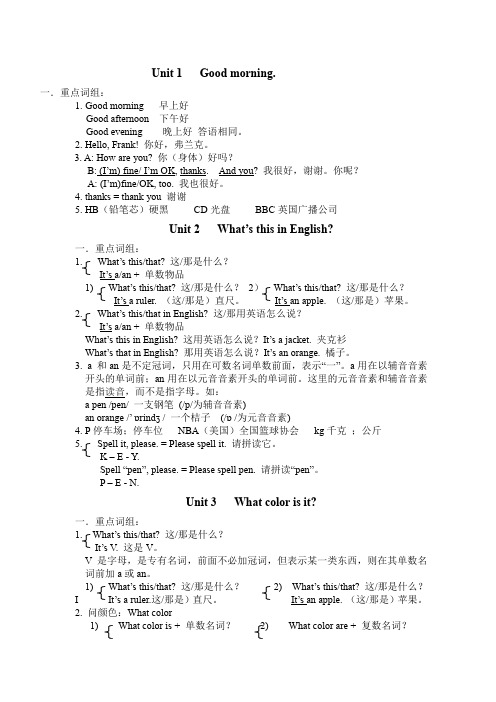
Unit 1 Good morning.一.重点词组:1.Good morning 早上好Good afternoon 下午好Good evening 晚上好答语相同。
2. Hello, Frank! 你好,弗兰克。
3. A: How are you? 你(身体)好吗?B: (I’m) fine/ I’m OK, thanks. And you? 我很好,谢谢。
你呢?A: (I’m)fine/OK, too. 我也很好。
4. thanks = thank you 谢谢5. HB(铅笔芯)硬黑CD光盘BBC英国广播公司Unit 2 What’s this in English?一.重点词组:1. What’s this/that? 这/那是什么?It’s a/an + 单数物品1) What’s this/that? 这/那是什么?2)What’s this/that? 这/那是什么?It’s a ruler. (这/那是)直尺。
It’s an apple. (这/那是)苹果。
2. What’s this/that in English? 这/那用英语怎么说?It’s a/an + 单数物品What’s this in English? 这用英语怎么说?It’s a jacket. 夹克衫What’s that in English? 那用英语怎么说?It’s an orange. 橘子。
3. a 和an是不定冠词,只用在可数名词单数前面,表示“一”。
a用在以辅音音素开头的单词前;an用在以元音音素开头的单词前。
这里的元音音素和辅音音素是指读音,而不是指字母。
如:a pen /pen/ 一支钢笔(/p/为辅音音素)an orange /’ ɒrindʒ / 一个桔子(/ɒ /为元音音素)4. P停车场;停车位NBA(美国)全国篮球协会kg千克;公斤5. Spell it, please. = Please spell it. 请拼读它。
鲁教新版英语六年级下册第六单元知识点
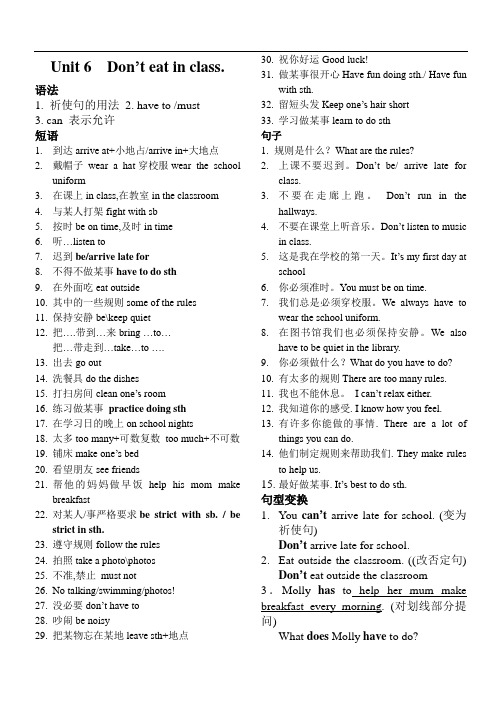
Unit 6 Don’t eat in class.语法1. 祈使句的用法2. have to /must3. can 表示允许短语1.到达arrive at+小地占/arrive in+大地点2.戴帽子wear a hat穿校服wear the schooluniform3.在课上in class,在教室in the classroom4.与某人打架fight with sb5.按时be on time,及时in time6.听…listen to7.迟到be/arrive late for8.不得不做某事have to do sth9.在外面吃eat outside10.其中的一些规则some of the rules11.保持安静be\keep quiet12.把….带到…来bring …to…把…带走到…take…to ….13.出去go out14.洗餐具do the dishes15.打扫房间clean one’s room16.练习做某事practice doing sth17.在学习日的晚上on school nights18.太多too many+可数复数too much+不可数19.铺床make one’s bed20.看望朋友see friends21.帮他的妈妈做早饭help his mom makebreakfast22.对某人/事严格要求be strict with sb. / bestrict in sth.23.遵守规则follow the rules24.拍照take a photo\photos25.不准,禁止must not26.No talking/swimming/photos!27.没必要don’t have to28.吵闹be noisy29.把某物忘在某地leave sth+地点30.祝你好运Good luck!31.做某事很开心Have fun doing sth./ Have funwith sth.32.留短头发Keep one’s hair short33.学习做某事learn to do sth句子1. 规则是什么?What are the rules?2.上课不要迟到。
英语鲁教版六年级下册 知识点
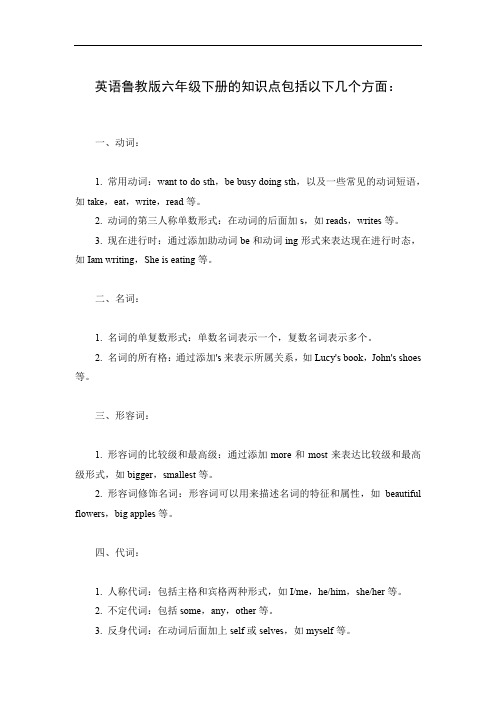
英语鲁教版六年级下册的知识点包括以下几个方面:一、动词:1. 常用动词:want to do sth,be busy doing sth,以及一些常见的动词短语,如take,eat,write,read等。
2. 动词的第三人称单数形式:在动词的后面加s,如reads,writes等。
3. 现在进行时:通过添加助动词be和动词ing形式来表达现在进行时态,如Iam writing,She is eating等。
二、名词:1. 名词的单复数形式:单数名词表示一个,复数名词表示多个。
2. 名词的所有格:通过添加's来表示所属关系,如Lucy's book,John's shoes 等。
三、形容词:1. 形容词的比较级和最高级:通过添加more和most来表达比较级和最高级形式,如bigger,smallest等。
2. 形容词修饰名词:形容词可以用来描述名词的特征和属性,如beautiful flowers,big apples等。
四、代词:1. 人称代词:包括主格和宾格两种形式,如I/me,he/him,she/her等。
2. 不定代词:包括some,any,other等。
3. 反身代词:在动词后面加上self或selves,如myself等。
五、句型转换:1. 疑问句:将一个陈述句转换为疑问句,需要改变动词的时态和语序。
2. 否定句:在动词前面加上not或者使用never来表示否定意义。
3. 一般现在时:表示通常或反复发生的动作或状态。
4. 一般过去时:表示过去发生的动作或状态。
5. 现在进行时:表示现在正在进行的动作或正在发生的状况。
6. 现在完成时:表示过去发生的动作对现在造成的影响或结果。
7. 比较级和最高级的使用。
8. 祈使句:表达命令、请求或建议的语言。
9. 语态转换:包括被动语态和主动语态的转换等。
以上是英语鲁教版六年级下册的部分知识点,对于每个知识点的学习和应用需要结合具体语境和语料进行深入理解和实践练习。
鲁教版(五四制)六年级英语下册各单元重点知识汇总
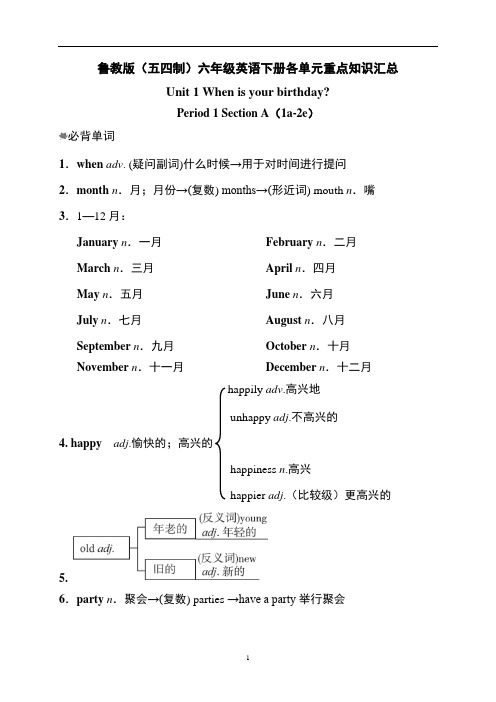
鲁教版(五四制)六年级英语下册各单元重点知识汇总Unit 1 When is your birthday?Period 1 Section A(1a-2e)必背单词1.when adv. (疑问副词)什么时候→用于对时间进行提问2.month n.月;月份→(复数) months→(形近词) mouth n.嘴3.1—12月:January n.一月February n.二月March n.三月April n.四月May n.五月June n.六月July n.七月August n.八月September n.九月October n.十月November n.十一月December n.十二月happily adv.高兴地unhappy adj.不高兴的4.happy adj.愉快的;高兴的happiness n.高兴happier adj.(比较级)更高兴的5.6.party n.聚会→(复数) parties →have a party举行聚会必背短语7.Alice's birthday艾丽斯的生日8.your father's birthday 你父亲的生日9.in August 在八月10.at three this afternoon今天下午三点钟必背句子11.—When is your birthday,Mike?迈克,你的生日是什么时候?—My birthday is on June 3rd.我的生日是在六月三日。
12.Happy birthday! 生日快乐!13.—How old are you? 你多大了?—I'm thirteen. 我十三岁了。
14. Well,do you want to come to my birthday party?哦,你想来参加我的生日聚会吗?15.—When is it? 聚会是在什么时候?—At three this afternoon. 今天下午三点钟。
鲁教版五四制英语六年级下Unit 1 核心知识点

六年级下册Unit1一、Vocabulary单词:1、Unit1全部单词2、1st-31st二、Phrases短语:1、几岁how old2、在八月in August3、想要做want to do4、来参加我的生日聚会come to my birthday party5、在三点钟at three6、今天下午this afternoon7、在今天下午三点at three this afternoon8、在四月一日on April1st9、你哥哥的生日your brother’s birthday10、。
怎么样?How about...11、英语测试English test12、学校郊游school trip13、篮球比赛basketball game14、足球比赛soccer game15、英语日English Day16、艺术节art festival17、学校活动日School Day18、体育节/体育日Sports Day19、图书特卖会book sale20、这学期this term21、举办学校郊游have a school trip22、在上午/早上in the morning23、在下午in the afternoon24、在晚上in the evening25、在12和15号on the12th and the15th26、在9月26日和27日on September26th and27th27、举行两场球类比赛have two ball games28、来我们学校come to our school29、(在)下个月next month30、(在)下周next week31、举办艺术节have an art festival32、举办英语聚会have an English party33、举办售书活动have a book sale34、在学校图书馆in the school library35、这些中国的节日these holidays in China36、。
鲁教版五四制英语六年级下册Unit1 【语法专项】:序数词和名词所有格的用法

【语法专项】:序数词和名词所有格的用法一、序数词序数词是表示顺序的数词。
序数词前常加定冠词the。
序数词的词形变化及其缩写形式:1.第1,2,3是独立的特殊形式,first 1st;second 2nd;third 3rd2.从4到19的序数词,是在相应的基数词的词尾加th,特别注意第五、第八、第九、第十二;fourth 4th;fifth 5th;sixth 6th,seventh 7th;eighth 8th;ninth 9th;tenth 10th;eleventh 11th;twelfth 12th3.20到90这些整十的数词,其相应的基数词都是以ty结尾,序数词一般是把基数词词尾的y变成ie,再加th。
twentieth 20th;thirtieth 30th;fortieth 40th;fiftieth 50th;sixtieth 60th;seventieth 70th;eightieth 80th;ninetieth 90th4.其余的两位数,只需将其相应基数词的个位改成序数词。
twentyfirst 21st;thirty-fourth 34th;sixtyninth 69th;ninetythird 93rd巧记基数词变为序数词:一、二、三要牢记,其余后面加th。
th里边有例外,你要格外记明白。
八去t,九去e,ve要用f替。
几十变y为ie,跟着再加th。
几十几只变个位数。
序数词表顺序,一般要加定冠词。
二、名词的所有格在汉语中,我们常用“的”表示某物归谁所有。
如:老师的书;丽萍的尺子等。
英语中的这种所属关系就是名词所有格,相当于汉语中的“的”。
所有格的类型:1.“'s”所有格有生命物体的名词以及表示时间、距离、国家、城市等的名词常用“'s”所有格。
It's twenty minutes' walk.步行二十分钟的路程。
有以下几种加's的情况:a .单数名词后直接加“'s”。
鲁教版五四制英语六年级下册Unit4 语法学习:关于时间的问法
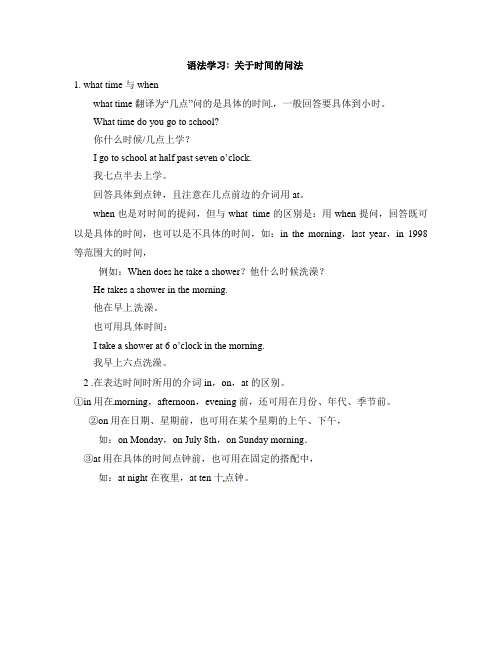
语法学习: 关于时间的问法
1. what time与when
what time翻译为“几点”问的是具体的时间,一般回答要具体到小时。
What time do you go to school?
你什么时候/几点上学?
I go to school at half past seven o’clock.
我七点半去上学。
回答具体到点钟,且注意在几点前边的介词用at。
when也是对时间的提问,但与what time的区别是:用when提问,回答既可以是具体的时间,也可以是不具体的时间,如:in the morning,last year,in 1998等范围大的时间,
例如:When does he take a shower?他什么时候洗澡?
He takes a shower in the morning.
他在早上洗澡。
也可用具体时间:
I take a shower at 6 o’clock in the morning.
我早上六点洗澡。
2 .在表达时间时所用的介词in,on,at的区别。
①in用在morning,afternoon,evening前,还可用在月份、年代、季节前。
②on用在日期、星期前,也可用在某个星期的上午、下午,
如:on Monday,on July 8th,on Sunday morning.
③at用在具体的时间点钟前,也可用在固定的搭配中,
如:at night在夜里,at ten十点钟。
六年级英语下册知识讲义-Units 3-4语法归纳-鲁教版(五四学制)
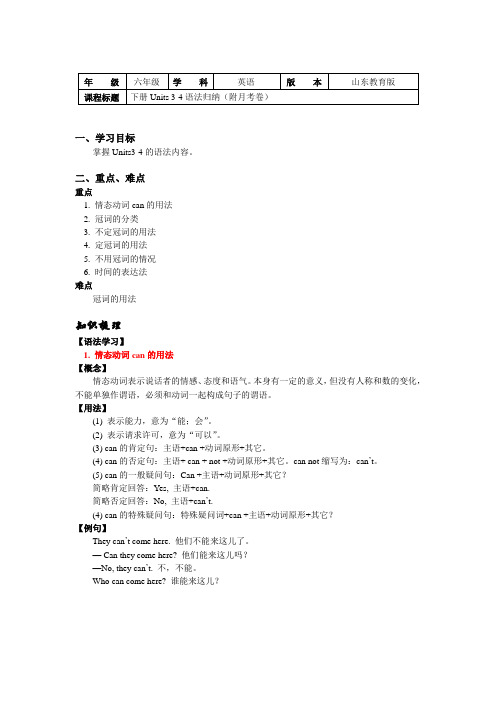
一、学习目标掌握Units3-4的语法内容。
二、重点、难点重点1. 情态动词can的用法2. 冠词的分类3. 不定冠词的用法4. 定冠词的用法5. 不用冠词的情况6. 时间的表达法难点冠词的用法知识梳理【语法学习】1. 情态动词can的用法【概念】情态动词表示说话者的情感、态度和语气。
本身有一定的意义,但没有人称和数的变化,不能单独作谓语,必须和动词一起构成句子的谓语。
【用法】(1) 表示能力,意为“能;会”。
(2) 表示请求许可,意为“可以”。
(3) can的肯定句:主语+can +动词原形+其它。
(4) can的否定句:主语+ can + not +动词原形+其它。
can not缩写为:can’t。
(5) can的一般疑问句:Can +主语+动词原形+其它?简略肯定回答:Yes, 主语+can.简略否定回答:No, 主语+can’t.(4) can的特殊疑问句:特殊疑问词+can +主语+动词原形+其它?【例句】They can’t come here. 他们不能来这儿了。
— Can they come here? 他们能来这儿吗?—No, they can’t. 不,不能。
Who can come here? 谁能来这儿?【考题链接】—_____ he swim?—Yes, he can.A. DoesB. DoC. CanD. Is答案:C思路分析:根据答语he can可知问句用can提问,故选C项。
【拓展】情态动词must的用法:(1) 意为“必须”,表示义务、命令或要求。
(2) 含有must的一般疑问句其否定回答用:needn’t。
【例句】We must speak English in class. 我们必须在课堂上说英语。
— Must he go there? 他必须去那儿吗?—No, he needn’t. 不,他不必。
【即学即练】用can或can’t 填空1. I can play soccer, but I _____ play basketball.2. —Can you play chess?—Yes, I _____.3. I’m sorry I _____ speak English.4. _____ you bring some strawberries to me?5. —____ your father swim?—No, he _____.答案:1. can’t 2. can 3. can’t 4. Can 5. Can; can’t2. 冠词【概念】冠词是一种虚词,不能单独承担一个句子成分,只能和一个名词一起使用,帮助说明其词义。
鲁教版五四制英语六年级下册Unit7 语法点滴
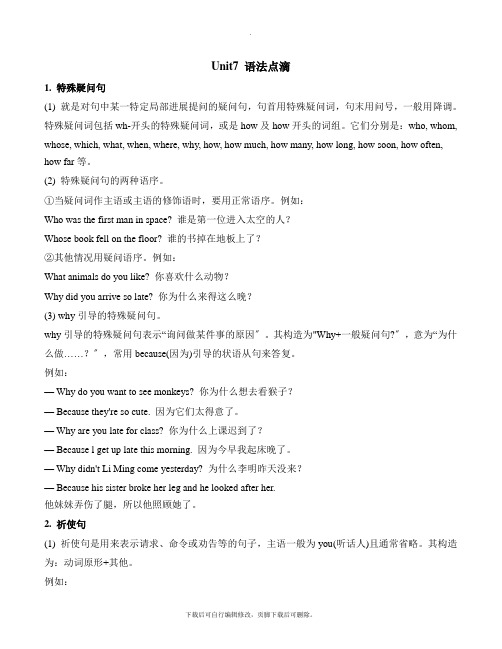
Unit7 语法点滴1. 特殊疑问句(1) 就是对句中某一特定局部进展提问的疑问句,句首用特殊疑问词,句末用问号,一般用降调。
特殊疑问词包括wh-开头的特殊疑问词,或是how及how开头的词组。
它们分别是:who, whom, whose, which, what, when, where, why, how, how much, how many, how long, how soon, how often, how far等。
(2) 特殊疑问句的两种语序。
①当疑问词作主语或主语的修饰语时,要用正常语序。
例如:Who was the first man in space? 谁是第一位进入太空的人?Whose book fell on the floor? 谁的书掉在地板上了?②其他情况用疑问语序。
例如:What animals do you like? 你喜欢什么动物?Why did you arrive so late? 你为什么来得这么晚?(3) why引导的特殊疑问句。
why引导的特殊疑问句表示“询问做某件事的原因〞。
其构造为"Why+一般疑问句?〞,意为“为什么做……?〞,常用because(因为)引导的状语从句来答复。
例如:— Why do you want to see monkeys? 你为什么想去看猴子?— Because they're so cute. 因为它们太得意了。
— Why are you late for class? 你为什么上课迟到了?— Because l get up late this morning. 因为今早我起床晚了。
— Why didn't Li Ming come yesterday? 为什么李明昨天没来?— Because his sister broke her leg and he looked after her.他妹妹弄伤了腿,所以他照顾她了。
鲁教版英语(五四制)六年级下册_Unit8_单元知识点汇总

Unit8 单元知识点汇总【短语归纳】1. watch TV 看电视2. read a newspaper 看报纸3. talk on the phone 通过电话交谈4. listen to 听5. use the computer 使用电脑6. make soup做汤7. wash the dishes 洗餐具8. kind of 有点儿【用法集萃】1. —What + be+ 主语+ doing? ……正在做什么?—主语+ be + doing sth. ……正在做某事。
2. I’d love / like to do sth. 我愿意做某事。
3. any other +可数名词单数其他任何一个……4. wish to do sth. 希望做某事【典句必背】1. —Why are you doing? 你在做什么?—I’m watching TV. 我在看电视。
2. —What’s she doing?她在做什么?—She’s washing her clothes. 她在洗她的衣服。
3. —What are they doing? 他们在做什么?—They’re listening to a CD. 他们在听一张CD唱片。
4. —Are you doing your homework? 你在做你的家庭作业吗?—Yes, I am. / No, I’m not. I’m cleaning my room.是的,我在做。
/不,我没有。
我在打扫我的房间。
5. Zhu Hui misse s his family and wishes to have his mom’s delicious zongzi.朱辉思念他的家人并希望吃上他妈妈的可口粽子。
【重点句式】1. 现在进行时的结构:主语+be+v-ing. (be动词和动词-ing两者缺一不可)考题形式:(1)已知be动词,考后面的动词形式(要加ing);(2) 已知后面的动词+ing,则前面用be动词。
鲁教版六年级下册英语全册知识点整理
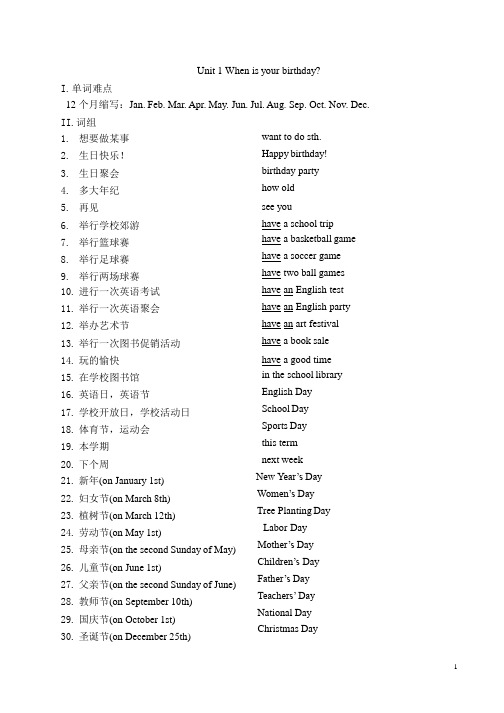
English Day
17. 学校开放日,学校活动日
School Day
18. 体育节,运动会 19. 本学期 20. 下个周 21. 新年(on January 1st) 22. 妇女节(on March 8th) 23. 植树节(on March 12th) 24. 劳动节(on May 1st) 25. 母亲节(on the second Sunday of May) 26. 儿童节(on June 1st) 27. 父亲节(on the second Sunday of June) 28. 教师节(on September 10th) 29. 国庆节(on October 1st) 30. 圣诞节(on December 25th)
3. 生日聚会
birthday party
4. 多大年纪
how old
5. 再见
see you
6. 举行学校郊游
have a school trip
7. 举行篮球赛 8. 举行足球赛 9. 举行两场球赛 10. 进行一次英语考试
have a basketball game have a soccer game have two ball games have an English test
24. 对某人严格要求
be strict with sb.
25. 对某事严格要求
be strict in sth.
II. Sentences (句子) (P9 Grammar Focus)
1. 让我们周六见吧。
Let’s meet on Saturday.
2. 今天星期几?
What day is it today?
Unit 1 When is your birthday?
鲁教版六下英语知识点精华

65.watch…doing 观看…正在做某事 66. enjoy doing 喜欢做…… 67. spend time doing sth. 花时间做某事 68. Go along Bridge Street and turn left when (当)you see the library.(指路句型) 69.It takes sb. sometime to do 花费某人多 长时间做某事 70.hope/wish to do希望做某事
46. After dinner, I can’t relax either.晚饭后, 我也不能放松。 47.It’s important for sb. to do sth. 对某人来 说做某事很重要。It’s best to do th 记住去做某事 remember doing sth. 记得做了某事
39. do/wash the dishes 洗盘子 40. be strict with sb. in sth. 就某事对某人 要求严格 41. learn to play the guitar 学习弹吉他 42. have fun/a good time doing sth. 做某事 玩的开心 43.practice doing sth. 练习做某事 44.too many+可数名词复数,太多; too much +不可数名词, 太多 45.much too+形容词 太…
49. Let’s(not) do …让我们(不)做… 50.be from= come from 来自
51. kind of boring 有点无聊 52. like… a lot 非常喜欢… 53.one of Thailand’s symbols 泰国的象征 之一 (单数) 54.be in great danger 在巨大的危险中 55.buy things made of ivory 买象牙做的东 西 56. cut down many trees =cut them down 57.go to the movies 去看电影 58.any other night 其他任何一个夜晚
山东六年级下册英语知识点
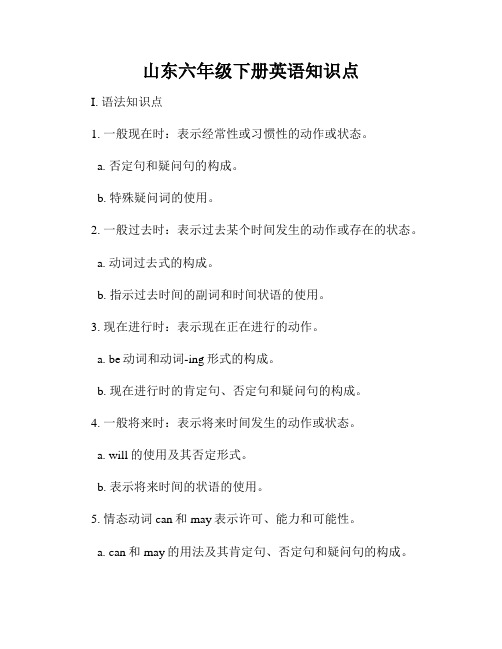
山东六年级下册英语知识点I. 语法知识点1. 一般现在时:表示经常性或习惯性的动作或状态。
a. 否定句和疑问句的构成。
b. 特殊疑问词的使用。
2. 一般过去时:表示过去某个时间发生的动作或存在的状态。
a. 动词过去式的构成。
b. 指示过去时间的副词和时间状语的使用。
3. 现在进行时:表示现在正在进行的动作。
a. be动词和动词-ing形式的构成。
b. 现在进行时的肯定句、否定句和疑问句的构成。
4. 一般将来时:表示将来时间发生的动作或状态。
a. will的使用及其否定形式。
b. 表示将来时间的状语的使用。
5. 情态动词can和may表示许可、能力和可能性。
a. can和may的用法及其肯定句、否定句和疑问句的构成。
b. 情态动词can和may在对话中的运用。
II. 词汇知识点1. 数词:表示具体的数字或数量的词汇。
a. 基数词和序数词的区别及其基本用法。
b. 表示时间的数词的使用。
2. 形容词的比较级和最高级:表示程度高低或者比较的用法。
a. 一般形容词的比较级和最高级形式的构成。
b. 特殊形容词的比较级和最高级形式的变化规则。
3. 动词短语:由动词和其他词组成的固定搭配。
a. 常用的动词短语及其意义和用法。
b. 动词短语的变换和运用。
4. 日常生活用语:与日常生活密切相关的词汇。
a. 问候语和寒暄用语。
b. 询问和描述日常生活中的活动。
III. 阅读理解1. 获取信息:根据文章内容回答问题或填写相关信息。
a. 阅读文章,理解文章的主要内容。
b. 根据问题或空格要求,从文章中寻找相关信息并作答。
2. 选择正确答案:根据文章理解选择正确答案。
a. 阅读问题和选项,理解问题的要求。
b. 根据问题的要求,在文章中找到相关信息,选择正确答案。
3. 补全对话或短文:填写对话或短文中的空白部分。
a. 阅读对话或短文,理解对话或短文的主题和基本内容。
b. 根据对话或短文的语境和上下文,填写合适的词语或句子。
IV. 写作技巧1. 书信写作:根据指定的写作要求,撰写书信。
- 1、下载文档前请自行甄别文档内容的完整性,平台不提供额外的编辑、内容补充、找答案等附加服务。
- 2、"仅部分预览"的文档,不可在线预览部分如存在完整性等问题,可反馈申请退款(可完整预览的文档不适用该条件!)。
- 3、如文档侵犯您的权益,请联系客服反馈,我们会尽快为您处理(人工客服工作时间:9:00-18:30)。
一、鲁教版英语六年级下册语法1、情态动词情态动词表示说话人对所说动作的观点,如需要、可能、意愿、怀疑等。
在形式上,情态动词一般没有人称和数的变化,有的情态动词没有时态的变化,如must。
情态动词本身词义不完全,不能单独作谓语动词,必须和不带“to”的动词原形连用。
常见情态动词有can,may,must,have to,should,would等。
情态动词一般有多个意义。
情态动词的否定式一般是在其后面加not构成,一般疑问句通常将其提到句首。
情态动词的肯定式一般不重读。
1)can(1)表示能力We can speak a little English.Her sister can play the violin.I can play badminton but I can’t play volleyball.(2)表示许可You can play basketball on weekends.We can’t run in the hallways.(3)表示请求Can you help me with my Chinese?Could you tell him to call me back?(这儿的could比can更委婉。
)2)must表示“必须”Don’t arrive late for class. We must be on time.Molly must do her homework first when she gets home.3)have to表示“不得不”,“必须”We have to be quiet in the library.She has to do her homework first when she gets home.have to表示“必须”时与must意义很接近,有时可与must互换。
例如:We have to/must follow the rules.但在以下方面有所不同:(1)must通常表示的是说话人的主观看法,语气比较强列,have to往往强调客观需要,例如:I must go now.It’s a little late and I have to go now.(2)它们的否定式含义大不相同。
mustn’t表示“不准”、“禁止”,而don’t have to表示“不必”。
例如:You mustn’t talk to your mother like that.You don’’t want to.(3)must一般只表示现在,没有人称和数的变化。
而have to则可以用于不同的时态,有人称和数的变化。
例如:I/We/You/They must do something about it.I have to finish my work today.She has to finish her work today.They had to get to the station before 5:00.2、现在进行时1)现在进行时表示现在(说话瞬间)正在进行或发生的动作。
例如:The students are listening to the teacher.He is watching TV now.现在进行时也可表示当前一段时间内的活动或现阶段正在进行的动作。
例如:We are working on a farm these days.I’m reading a history book this month.2)现在进行时是由助动词be(am/is/are)加动词-ing形式构成的。
以动词work为例,现在进行时的肯定式、否定式、疑问式和简略答语如下:肯定式否定式I am working.He/She is working.We/You/They are working.I am not working.He/She is not working.We/You/They are not working.疑问式和简略答语Am I working?Yes, you are.No, you are not(aren’t).Are we working?Yes, we/you are.No, we/you are not (aren’t).Are you working? Yes, I am.No, I am not.Are you working?Yes, you are.No, you are not (aren’t).Is he/she working? Yes, he/she is.No, he/she is not(isn’t).Are they working?Yes, they are.No, they are not (aren’t).3)动词-ing形式的构成类别构成方法例词一般情况加-ing go---goingask---askinglook---looking以不发音字母e结尾的动词去掉e,再加-ing write---writingmake---makingtake---taking以重读闭音节结尾的动词,末尾只有一个辅音字母双写这个辅音字母,再加-ingget---gettingsit----sittingput---puttingrun---runningbegin---beginning二、There be结构There be结构的一般现在时是There is/are。
“There is/are+某物/某人+某地/某时”结构表示“某地或某时有某物或某人”。
这种结构中的there没有实际意义。
句子中的be(is/are)和后面所跟的名词在数方面必须一致。
There be结构的一般现在时基本句型如下:句式一般现在时肯定式There is (There’s) a supermarket on that road.There are many people here on vacation.There is (There’s) some ice on the lake.否定式There isn’t a supermarket on that road.There aren’t many people here on vacation.There isn’t any ice on the lake.疑问式Is there a supermarket on that road?Are there many people here on vacation?Is there any ice on the lake?在有并列主语的情况下,往往根据第一个主语的单复数来确定动词be的形式。
例如:There is a pen and two books on the desk.There are two boys and a girl in the room.三、数词1、基数词基数词表示数目的多少。
one 1 two 2 there 3 four 4 five 5 six 6 seven 7eight 8nine 9ten 10eleven 11twelve 12thirteen 13fourteen 14fifteen 15sixteen 16seventeen 17eighteen 18nineteen 19twenty 20twenty-one 21twenty-two 22thirty 30forty 40fifty 50sixty 60seventy 70eighty 80ninety 90one hundred 100one hundred andone 101two hundred 2002、序数词序数词表示事物的先后顺序,往往与定冠词the连用。
first 1st second 2nd third 3rd fourth 4th fifth 5th sixth 6th seventh 7th eight 8th ninth 9thtenth 10theleventh 11thtwelfth 12ththirteenth 13thfourteenth 14thfifteenth 15thsixteenth 16thseventeenth 17theighteenth 18thnineteenth 19thtwentieth 20thtwenty-first 21sttwenty-second 22ndthirtieth 30thfortieth 40thfiftieth 50thsixtieth 60thseventieth 70theightieth 80thninetieth 90thhundredth 100thone hundred and first101st四、介词介词一般位于名词或代词前,表示该词与句中其他成分的关系。
介词后面的名词或代词称为介词宾语(若是人称代词,则要用宾格)。
介词和介词宾语合在一起构成介词短语。
1、表示时间的介词表示时间的介词主要有at,on和in,它们的常见用法如下:at on in钟点 at six o’clock用餐 at lunch time 节日 at Christmas年龄 at the age of 20时间 at this time一天中的某段时间 at noon/at night 某一天的某时段on Saturday morning星期几 on Sunday日期 on May 4th节假日 on New Year’s Dayon weekendson vacation一天中的某段时间In the afternoon月份 in April季节 in spring年份 in 1949其他表示时间的介词还有before,after等,例如:before breakfast/class/school,afterbreakfast/class/school。
2、表示地点的介词表示地点的介词和介词短语很多,如at,in,on,near,next to,in front of,before,under,behind,beside,between,in the front of,in the middle of,at the back of等,其中最常用、最灵活的是at,in和on这三个介词。
比如,“在学校里”可以说in school,也可以说at school。
